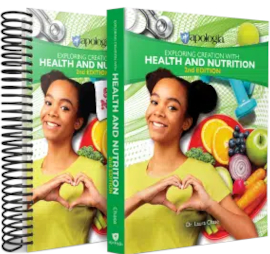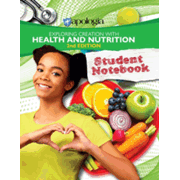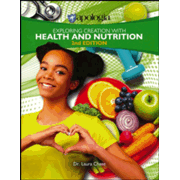Exploring Creation with Health and Nutrition is a high school course for Christian students that can be completed in one semester or, at a more leisurely pace, in two semesters. The course consists of a 443-page textbook and the 366-page Exploring Creation with Health and Nutrition: Student Notebook. The course is presented in 15 modules, each covering a set of related topics.
There is no teacher’s guide, though the publisher has a password-protected section on their website where you will find the answer keys. The Student Notebook provides brief information about how the course works, how to evaluate student work, and a suggested schedule. You need to read this first to understand how and when to use both books.
On page 16 of the textbook, the author defines health as, “the pursuit of balance physically, socially, mentally, emotionally, and spiritually.” As one would expect, the course discusses the systems of the human body in relation to health and nutrition, but it also includes modules titled Physical Influences on Thoughts and Feelings, Mental and Emotional Stability, Interpersonal Harmony, and Peace in Difficult Times. Physical fitness gets particular attention in Module 12: You’re Stronger Than You Look.
Plenty of practical applications are offered throughout the course. For instance, after a discussion about how to read food labels, there’s an activity that involves reading and interpreting a food label, and the module on physical fitness requires students to do a half hour of specific exercises for 15 days, keeping track on charts in the Student Notebook. In addition, every module includes one or two pages about a particular health profession for students to consider as a career.
A prior chemistry or biology course is not required, but those courses would provide helpful background for some of the scientific information, such as the discussion of the molecular structure of fatty acids in Module 7.
The course advocates for a healthy lifestyle in keeping with a Christian point of view. References to biblical beliefs and attitudes occur throughout the textbook, and the author assumes that students believe that biblical guidelines are authoritative.
Here are some examples.
- Students are told why they should avoid profanity in their communications.
- The textbook discusses sexually transmitted diseases, but it encourages abstinence outside of marriage.
- It explains how pornography affects the brain and strongly recommends avoiding it.
- Birth control is not addressed at all (possibly to avoid controversies among Christians).
- A page-long article against abortion in the textbook is titled, “The Pro-Life Arguments against Abortion and Learning to Ask Appropriate Questions.”
- A discussion about gender roles in the home, a subject likely to be controversial, begins by saying, “Because every organization needs one designated head, the Bible has given a man that responsibility for his family.”
How It Works
Students begin each module by taking notes as they read from the textbook. They have four lined pages for this purpose at the beginning of each module in the Student Notebook.
Scattered throughout each module in the textbook are “On Your Own” questions. The questions are repeated in the Student Notebook with space for students to write responses. These are a mixture of comprehension questions and others that ask students to analyze and apply what they have been learning. The questions are sometimes multiple-choice, but more often students will write out their own answers. Some questions have predictable answers, while others do not. For instance, On Your Own 4.11 asks students to match items in a column describing body language with items that describe the message conveyed by that body language (e.g., “excessive blinking or no blinking” matches with “lying”). On the other hand, students will write out their response to On Your Own 5.22 which asks, “Why is it a good thing that pain receptors adapt very slowly?”
At the end of each chapter in the textbook are answers to the On Your Own questions that have predictable answers. Students should write their answers in the Student Notebook before checking the provided answers.
The Student Notebook contains Study Guide Review Questions to help students prepare for the course's exams for all except three modules. (Those three modules have lengthier projects that will be used for evaluation instead of exams.) Students are supposed to study their notes and then try to answer these questions in the Student Notebook without referring to their textbook. Parents should check student answers using the answer key on the publisher’s website. If students miss questions, they should review the pertinent material. They should then be ready to take the exam for that module. Again, the answer keys are on the publisher’s website.
Projects
Most modules include one or more projects. Background information for the projects is in the textbook, but complete instructions and space for recording observations, thoughts, or results are in the Student Notebook. The projects vary greatly in the amount of time and effort required. For example, Project 15.1 for Young Women has students read a quote from Halle Berry and a Bible passage regarding standards for feminine beauty, then answer five questions with their own thoughts. (A corresponding project for young men follows next.) On the other hand, projects such as the physical fitness one I already mentioned and a similar 10-day recording project on oral hygiene will be accomplished over weeks. Some projects require research and analysis, such as Project 8.7: Fast Food Findings which requires students to analyze their favorite fast-food meal in terms of calories, protein, fat, calcium, iron, sodium, and carbs. (They can research on the internet.) Then they create a list of healthier food choices, analyzing their content in the same fashion.
Summary
Exploring Creation with Health and Nutrition combines information with practical application and activities that should interest students. Using the textbook and the Student Notebook together makes it easy for students to complete the course working independently. While the publisher’s website says you can use the textbook on its own, I think the synergy of using the two books together is so valuable that I don’t recommend skipping the Student Notebook.












